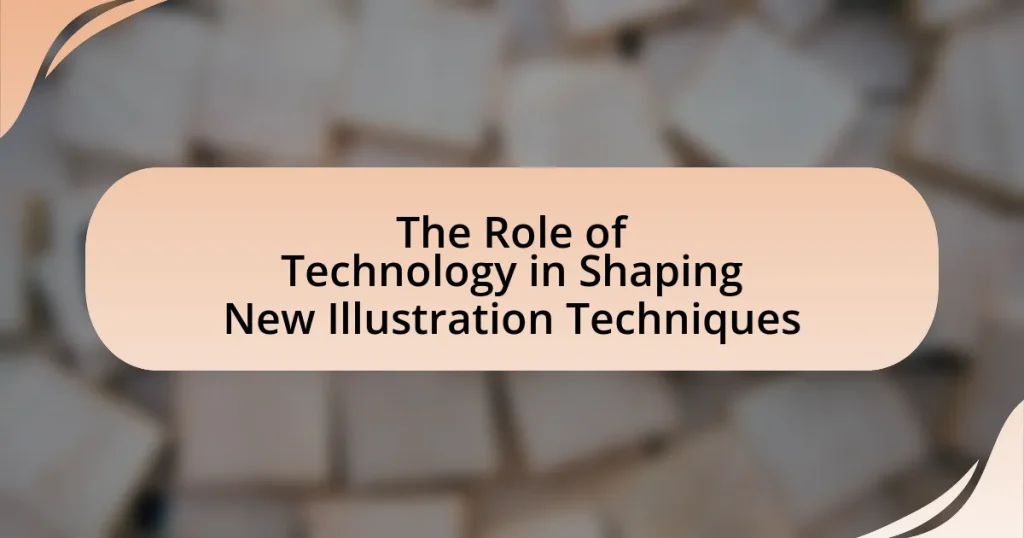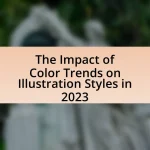The article examines the significant role of technology in shaping new illustration techniques, highlighting how digital tools and platforms enhance creativity and efficiency for artists. It discusses the impact of digital illustration software, 3D modeling tools, and augmented reality applications on traditional methods, emphasizing the advantages of flexibility and precision offered by these technologies. Additionally, the article addresses emerging trends such as artificial intelligence in illustration, the influence of social media on artistic styles, and the challenges illustrators face in adapting to rapid technological changes. Key strategies for maintaining creativity and effectively integrating new tools into workflows are also explored, providing a comprehensive overview of the evolving landscape of illustration in a technology-driven environment.
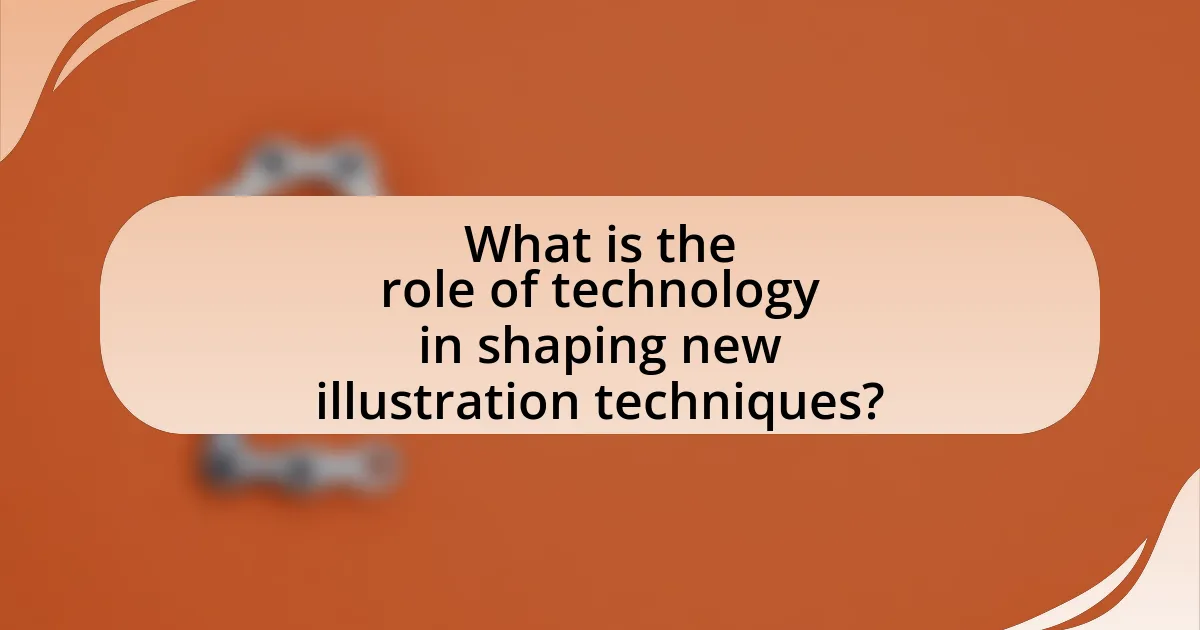
What is the role of technology in shaping new illustration techniques?
Technology plays a crucial role in shaping new illustration techniques by providing innovative tools and platforms that enhance creativity and efficiency. Digital software, such as Adobe Illustrator and Procreate, allows artists to experiment with various styles and techniques that were previously difficult or impossible to achieve with traditional media. Additionally, advancements in hardware, like graphic tablets and styluses, enable precise control and a more intuitive drawing experience. The rise of 3D modeling software and augmented reality applications further expands the possibilities for illustrators, allowing them to create immersive and interactive visuals. These technological advancements not only streamline the illustration process but also democratize access to high-quality tools, enabling a broader range of artists to explore and develop their unique styles.
How has technology influenced traditional illustration methods?
Technology has significantly influenced traditional illustration methods by introducing digital tools that enhance creativity and efficiency. Digital illustration software, such as Adobe Illustrator and Procreate, allows artists to create, edit, and manipulate images with precision and flexibility that traditional methods cannot match. For instance, the ability to easily undo mistakes, use layers, and apply various effects has transformed the workflow of illustrators, enabling them to experiment more freely. Additionally, advancements in hardware, like graphic tablets and styluses, have made it possible for artists to replicate the feel of traditional media while benefiting from digital capabilities. This shift has led to a blending of techniques, where traditional skills are applied in digital formats, resulting in innovative styles and approaches in the field of illustration.
What are the key technological advancements impacting illustration?
Key technological advancements impacting illustration include digital illustration software, 3D modeling tools, and augmented reality (AR) applications. Digital illustration software, such as Adobe Illustrator and Procreate, allows artists to create detailed and scalable artwork with precision and ease. 3D modeling tools, like Blender and ZBrush, enable illustrators to design complex three-dimensional visuals that enhance storytelling and visual depth. Augmented reality applications provide interactive experiences, allowing illustrations to come to life in real-world environments, thus expanding the creative possibilities for artists. These advancements have transformed traditional illustration methods, making them more versatile and accessible.
How do digital tools compare to traditional mediums in illustration?
Digital tools offer greater flexibility and efficiency compared to traditional mediums in illustration. While traditional mediums, such as pencil and paint, provide tactile experiences and unique textures, digital tools enable quick edits, layering, and a vast array of colors and effects that can be easily manipulated. For instance, software like Adobe Illustrator allows artists to create scalable vector graphics, which traditional mediums cannot achieve. Additionally, a study by the University of the Arts London found that digital illustrations can be produced in significantly less time than their traditional counterparts, highlighting the efficiency advantage of digital tools.
What are the emerging trends in illustration due to technology?
Emerging trends in illustration due to technology include the rise of digital tools, augmented reality (AR), and artificial intelligence (AI). Digital tools, such as Procreate and Adobe Fresco, enable illustrators to create intricate designs with ease and flexibility, allowing for rapid iterations and experimentation. Augmented reality enhances illustrations by integrating them into interactive experiences, as seen in projects like AR art installations that engage viewers in new ways. Artificial intelligence is transforming the illustration process through generative design, where algorithms assist artists in creating unique visuals, exemplified by tools like DALL-E and Midjourney. These advancements reflect a shift towards more dynamic, interactive, and personalized illustration practices, driven by technological innovation.
How are AI and machine learning transforming illustration practices?
AI and machine learning are transforming illustration practices by automating repetitive tasks, enhancing creativity, and enabling personalized content generation. These technologies allow illustrators to streamline workflows, such as generating initial sketches or color palettes, which significantly reduces the time spent on manual processes. For instance, tools like Adobe Sensei utilize machine learning algorithms to suggest design elements based on user preferences and past work, thereby improving efficiency. Additionally, AI-driven platforms can analyze vast datasets to create unique illustrations tailored to specific audiences, as seen in projects like DALL-E, which generates images from textual descriptions. This shift not only increases productivity but also expands the creative possibilities for artists, allowing them to focus more on conceptual development rather than technical execution.
What role do social media platforms play in the evolution of illustration styles?
Social media platforms significantly influence the evolution of illustration styles by providing artists with a global audience and immediate feedback. These platforms, such as Instagram and Pinterest, allow illustrators to showcase their work, leading to the rapid dissemination of new styles and trends. For instance, the rise of digital illustration has been propelled by the visibility artists gain through these channels, enabling them to experiment and innovate based on audience reactions. Additionally, the interactive nature of social media fosters collaboration and inspiration among artists, further diversifying illustration styles. This dynamic environment has led to the emergence of distinct aesthetics, such as minimalism and vibrant color palettes, which can be traced back to popular trends on these platforms.
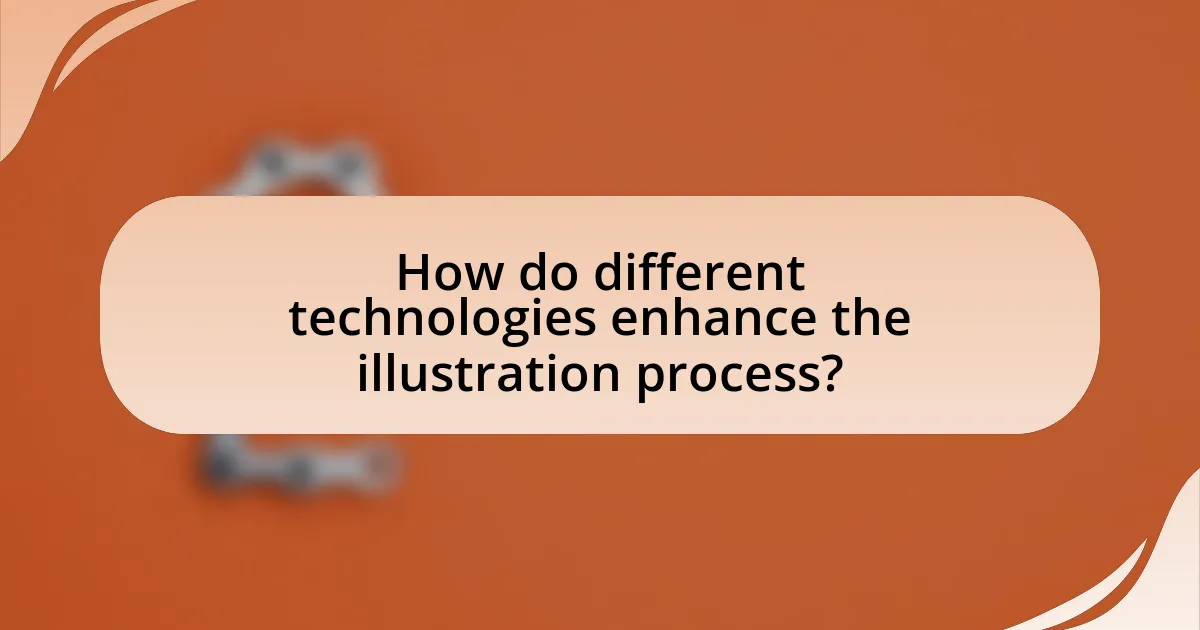
How do different technologies enhance the illustration process?
Different technologies enhance the illustration process by providing advanced tools that improve efficiency, creativity, and precision. Digital illustration software, such as Adobe Illustrator and Procreate, allows artists to create intricate designs with ease, offering features like layers, undo options, and a variety of brushes that traditional media cannot match. Additionally, 3D modeling software enables illustrators to visualize concepts in three dimensions, enhancing realism and depth in their work. Furthermore, artificial intelligence tools can assist in generating ideas or automating repetitive tasks, allowing artists to focus more on the creative aspects of their projects. These advancements not only streamline workflows but also expand the creative possibilities for illustrators, making the process more dynamic and accessible.
What software and tools are essential for modern illustrators?
Modern illustrators essential software and tools include Adobe Illustrator, Adobe Photoshop, Procreate, CorelDRAW, and Clip Studio Paint. Adobe Illustrator and Photoshop are industry standards for vector and raster graphics, respectively, widely used for their extensive features and capabilities. Procreate is favored for its intuitive interface and powerful brush engine, particularly among digital artists using iPads. CorelDRAW offers robust vector graphic design tools, while Clip Studio Paint is popular for comic and manga illustration due to its specialized features. These tools collectively enhance creativity and efficiency in the illustration process, reflecting the significant impact of technology on contemporary artistic practices.
How do graphic design software applications improve workflow?
Graphic design software applications improve workflow by streamlining design processes and enhancing collaboration among team members. These applications offer features such as templates, automated tools, and real-time editing, which reduce the time spent on repetitive tasks and allow designers to focus on creativity. For instance, Adobe Creative Cloud enables multiple users to work on a project simultaneously, facilitating immediate feedback and faster iterations. According to a study by the Nielsen Norman Group, teams using collaborative design tools reported a 30% increase in productivity, demonstrating the effectiveness of these applications in optimizing workflow.
What are the benefits of using 3D modeling in illustration?
The benefits of using 3D modeling in illustration include enhanced realism, improved visualization, and greater flexibility in design. Enhanced realism is achieved through the ability to create detailed textures and lighting effects that mimic real-world objects, making illustrations more lifelike. Improved visualization allows artists to manipulate perspectives and angles easily, providing a comprehensive view of the subject matter. Greater flexibility in design enables quick adjustments and iterations, streamlining the creative process. These advantages are supported by the widespread adoption of 3D modeling software in various industries, demonstrating its effectiveness in producing high-quality illustrations.
How does technology facilitate collaboration among illustrators?
Technology facilitates collaboration among illustrators by providing digital platforms and tools that enable real-time communication and sharing of work. For instance, software like Adobe Creative Cloud allows multiple illustrators to work on the same project simultaneously, enhancing efficiency and creativity. Additionally, cloud storage solutions such as Google Drive enable easy access to files and resources, ensuring that all collaborators can contribute regardless of their location. This interconnectedness is supported by statistics indicating that remote collaboration tools have increased productivity by up to 30% in creative industries, demonstrating the significant impact of technology on collaborative illustration efforts.
What platforms enable real-time collaboration on illustration projects?
Platforms that enable real-time collaboration on illustration projects include Figma, Adobe Creative Cloud, and Miro. Figma allows multiple users to work on design files simultaneously, providing features like commenting and version history, which enhances teamwork. Adobe Creative Cloud offers collaborative tools such as Adobe Fresco and Adobe XD, enabling artists to share and edit illustrations in real-time. Miro serves as a digital whiteboard that supports visual collaboration, allowing teams to brainstorm and create illustrations together. These platforms are widely recognized for their effectiveness in facilitating collaborative illustration work.
How has remote work influenced collaborative illustration techniques?
Remote work has significantly influenced collaborative illustration techniques by enabling real-time digital collaboration across geographical boundaries. Tools such as Adobe Creative Cloud, Figma, and Miro facilitate simultaneous contributions from multiple illustrators, allowing for immediate feedback and iterative design processes. A study by the International Journal of Design found that remote collaboration tools enhance creativity and productivity by providing a platform for diverse ideas to merge, leading to innovative outcomes. This shift has transformed traditional workflows, making them more flexible and inclusive, ultimately resulting in richer collaborative illustrations.
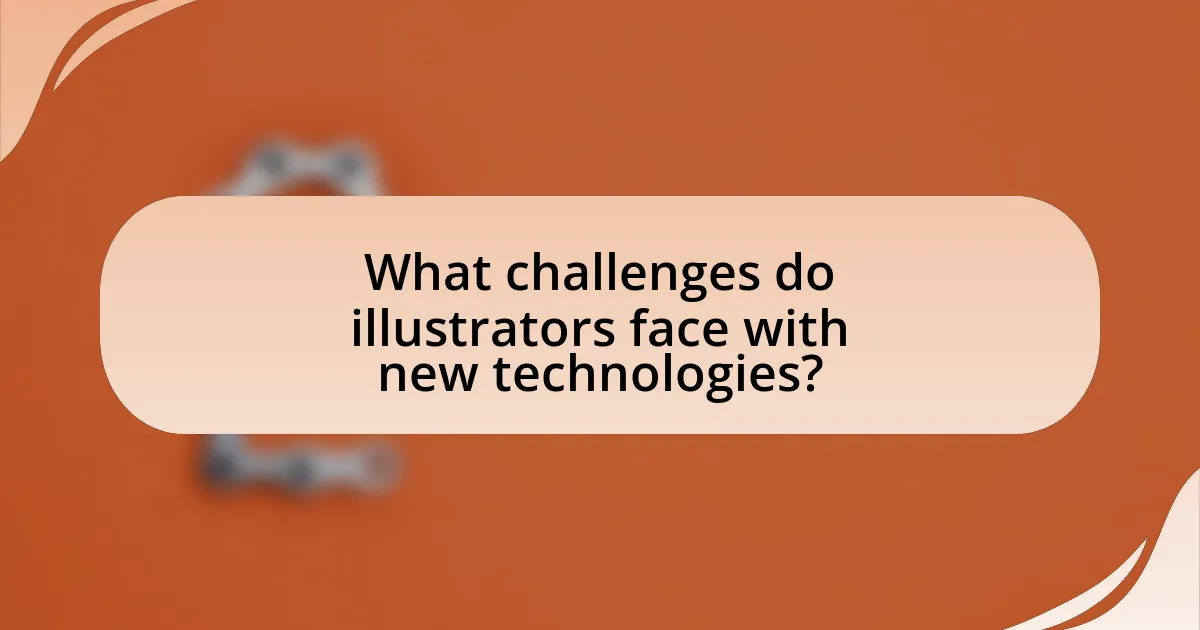
What challenges do illustrators face with new technologies?
Illustrators face several challenges with new technologies, including the need for continuous skill adaptation, increased competition, and the potential for diminished originality. As technology evolves, illustrators must frequently learn new software and tools, which can be time-consuming and may require significant investment in training. Additionally, the accessibility of digital tools has led to a saturated market, making it harder for individual illustrators to stand out. Furthermore, reliance on technology can sometimes result in a homogenization of styles, where unique artistic voices are overshadowed by trends driven by popular software features. These challenges highlight the complexities illustrators encounter as they navigate the intersection of art and technology.
What are the common technical issues illustrators encounter?
Common technical issues illustrators encounter include software compatibility problems, hardware limitations, and file management challenges. Software compatibility issues arise when different programs or versions do not work seamlessly together, leading to potential loss of work or functionality. Hardware limitations, such as insufficient RAM or outdated graphics tablets, can hinder performance and slow down the creative process. Additionally, file management challenges, including difficulties in organizing, saving, and exporting files in the correct formats, can disrupt workflow and lead to errors in final outputs. These issues are frequently reported in industry surveys, highlighting their impact on productivity and creativity among illustrators.
How can illustrators troubleshoot software-related problems?
Illustrators can troubleshoot software-related problems by systematically identifying the issue, consulting user manuals or online resources, and utilizing community forums for specific guidance. For instance, if an illustrator encounters a software crash, they should first check for updates or patches from the software provider, as many issues are resolved through regular updates. Additionally, accessing forums like Adobe Support Community can provide insights from other users who have faced similar challenges, offering practical solutions. This methodical approach ensures that illustrators can effectively resolve software issues, enhancing their workflow and productivity.
What are the limitations of current illustration technologies?
Current illustration technologies face several limitations, including a lack of versatility, high costs, and accessibility issues. These technologies often struggle to replicate the nuanced textures and details found in traditional media, which can hinder artistic expression. Additionally, software and hardware required for advanced illustration can be prohibitively expensive, limiting access for emerging artists. Furthermore, the steep learning curve associated with many digital tools can deter users, particularly those without prior experience in digital art. These factors collectively restrict the potential of illustration technologies to fully meet the diverse needs of artists and illustrators today.
How can illustrators adapt to the rapid technological changes?
Illustrators can adapt to rapid technological changes by continuously updating their skills and embracing new tools and software. This adaptation involves engaging in regular training and workshops to learn about advancements in digital illustration techniques, such as vector graphics and 3D modeling. For instance, a survey by the National Endowment for the Arts found that 70% of artists who utilized digital tools reported increased efficiency and creativity in their work. Additionally, illustrators can join online communities and forums to share knowledge and stay informed about industry trends, ensuring they remain competitive in a technology-driven market.
What skills should illustrators develop to stay relevant in the industry?
Illustrators should develop digital proficiency, adaptability to new technologies, and strong communication skills to stay relevant in the industry. Digital proficiency is essential as the industry increasingly relies on software tools like Adobe Creative Suite and Procreate, which are standard in creating modern illustrations. Adaptability to new technologies, such as augmented reality and 3D modeling, allows illustrators to explore innovative techniques and meet evolving client demands. Strong communication skills are crucial for collaborating with clients and understanding project requirements, ensuring that illustrators can effectively convey their ideas and concepts. These skills are supported by industry trends indicating a shift towards digital platforms and collaborative projects, highlighting the need for illustrators to be versatile and tech-savvy.
How can continuous learning benefit illustrators in a tech-driven environment?
Continuous learning benefits illustrators in a tech-driven environment by enabling them to stay updated with the latest tools and techniques, which enhances their creative capabilities. As technology evolves, new software and digital platforms emerge, offering advanced features that can significantly improve the quality and efficiency of illustrations. For instance, a study by Adobe found that 75% of creative professionals believe that learning new software directly impacts their productivity and creativity. By engaging in continuous learning, illustrators can adapt to these changes, incorporate innovative methods into their work, and maintain a competitive edge in the industry.
What best practices should illustrators follow when using technology?
Illustrators should prioritize mastering digital tools and software to enhance their creative process and output quality. Familiarity with industry-standard software like Adobe Illustrator and Procreate allows illustrators to efficiently create and manipulate their artwork. Additionally, maintaining an organized digital workspace is crucial; this includes proper file management and version control to avoid loss of work and ensure easy access to projects.
Regularly updating software and hardware is also essential, as it ensures access to the latest features and security improvements, which can significantly impact productivity. Furthermore, illustrators should engage with online communities and resources to stay informed about emerging technologies and techniques, fostering continuous learning and adaptation in a rapidly evolving field.
Lastly, backing up work in multiple locations, such as cloud storage and external drives, is a critical practice to prevent data loss, which can be devastating for any creative professional. These best practices collectively enhance the efficiency, quality, and security of an illustrator’s work in the digital landscape.
How can illustrators effectively integrate new tools into their workflow?
Illustrators can effectively integrate new tools into their workflow by systematically evaluating the tools’ functionalities and aligning them with their creative processes. This involves first identifying specific needs within their current workflow, such as improving efficiency or enhancing creativity. Once needs are established, illustrators should explore tools that offer features addressing those needs, such as digital painting software or vector graphic applications.
For instance, a study by the National Endowment for the Arts found that 70% of artists reported increased productivity after adopting digital tools, indicating that the right technology can significantly enhance workflow. After selecting appropriate tools, illustrators should dedicate time to practice and familiarize themselves with the new software or hardware, ensuring they understand its capabilities and limitations.
Additionally, integrating new tools can be facilitated by seeking online tutorials, joining user communities, or participating in workshops, which provide valuable insights and tips from experienced users. This structured approach not only helps illustrators adapt to new technologies but also enhances their overall artistic output.
What strategies can help illustrators maintain creativity while using technology?
Illustrators can maintain creativity while using technology by integrating traditional techniques with digital tools. This hybrid approach allows artists to leverage the precision and versatility of technology while preserving the organic feel of hand-drawn elements. For instance, using digital tablets that mimic traditional media can enhance creativity by providing a familiar tactile experience. Research indicates that artists who blend traditional and digital methods often report higher satisfaction and creativity levels, as seen in studies published in the Journal of Creative Behavior, which highlight the benefits of diverse artistic practices. Additionally, setting specific time limits for technology use can encourage spontaneity and exploration, fostering innovative ideas.
